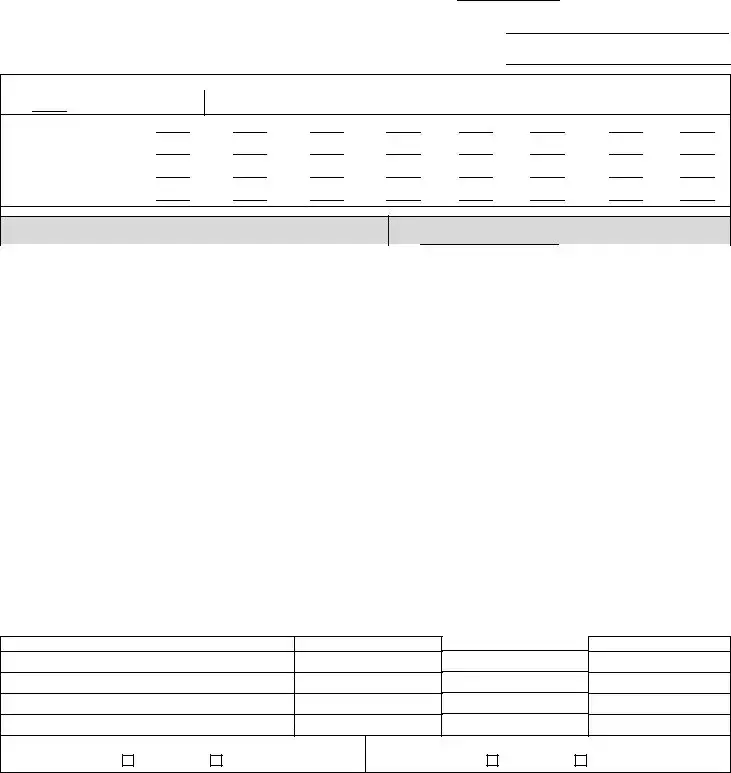LDSS-0857 (Rev. 4/2011)
|
|
|
|
|
|
|
NEW YORK STATE |
|
|
|
|
|
|
|
|
|
|
|
|
|
|
OFFICE OF CHILDREN AND FAMILY SERVICES |
|
|
|
|
|
REGISTRY NUMBER |
|
|
|
APPLICATION TO ADOPT |
|
APPLICATION DATE |
(For Official Use Only) |
|
|
|
|
(For Official Use Only) |
|
|
|
|
|
|
|
PART I |
|
|
|
|
|
|
|
|
|
|
|
|
|
|
|
Family Adoption Registry Information |
|
|
|
|
|
PROSPECTIVE PARENT’S NAME (Last, First, MI) |
|
|
|
|
DATE OF BIRTH |
YY |
ETHNICITY CODE |
|
RELIGION CODE |
|
|
|
|
|
|
|
|
|
MM, DD, |
|
|
|
|
|
|
|
|
|
|
|
|
|
|
|
|
|
|
PROSPECTIVE PARENT’S NAME (Last, First, MI) |
|
|
|
|
DATE OF BIRTH |
ETHNICITY CODE |
|
RELIGION CODE |
|
|
|
|
|
|
|
|
|
|
|
|
|
|
|
MM, DD, YY |
|
|
|
|
|
|
|
|
|
|
|
|
|
|
|
|
|
|
|
|
HOME ADDRESS (No., Street, Apt.) |
|
|
|
|
CITY/TOWN |
COUNTY |
|
|
STATE |
ZIP CODE |
|
|
|
|
|
|
|
|
HOME TELEPHONE NUMBER |
EMPLOYMENT TELEPHONE NO. (Prospective Adoptive Parent) |
|
EMPLOYMENT TELEPHONE NO. (Prospective Adoptive Parent) |
( |
) |
- |
( |
|
) |
- |
|
|
( |
|
|
) |
- |
|
|
|
FAMILY’S PRIMARY LANGUAGE CODE |
FAMILY’S SECONDARY LANGUAGE CODE |
FAMILY’S PET: |
|
E-Mail Address: |
|
|
|
|
|
|
|
|
|
|
|
|
|
|
|
|
@ |
|
|
NOTE: Select ALL acceptable characteristics. You may choose more than one entry in each area.
Age: |
|
Under 2 |
|
2-5 |
|
6-7 |
|
8-9 |
|
10-13 |
|
Over 13 |
Ethnicity Code:
Primary Language Code:
Secondary Language Code:
Religion Code:
ETHNICITY CODE
(FOR CHILD AND PARENTS)
LANGUAGE CODE
(FOR CHILD AND PARENTS)
AA |
Black or African American |
ASI |
Indian |
AI |
Nat Am Lan |
KM |
Cambodian |
AAC |
Caribbean |
ASJ |
Japanese |
AL |
Albanian |
KR |
Korean |
AAH |
Haitian |
ASK |
Korean |
AR |
Arabic |
LA |
Laotian |
AAN |
Native African |
ASX |
Other - Asian |
BN |
Bengali |
MU |
Multiple |
AAX |
Other - Black or African American |
HP |
Hispanic |
BS |
Bosnian |
NI |
NigeranIbo |
AL |
Alaskan Native |
ML |
Multiple |
CC |
Cantonese |
PJ |
Punjabi |
AM |
American Indian |
PI |
Native Hawaiian/Pacific Islander |
CF |
Fujianese |
PL |
Polish |
AS |
Asian |
WH |
White |
CH |
ChnseOther |
PR |
Portuguese |
ASC |
Chinese |
XNR |
Not Reported |
CM |
Mandarin |
PT |
Patois |
|
RELIGION CODE |
|
|
CR |
HaitnCreol |
RO |
Romanian |
|
(FOR CHILD AND PARENTS) |
|
CZ |
Czech |
RS |
Russian |
AT |
African Religion |
IS |
Muslim/Islamic |
EN |
English |
SC |
SerboCroat |
BA |
Baptist |
JW |
Jehovah's Witness |
ET |
Ethiopian |
SI |
Amer Sign |
BP |
Other Protestant |
LU |
Lutheran |
FA |
Farsi |
SL |
Braille |
BU |
Buddhist |
ME |
Methodist/Wesleyan |
FL |
Fulani |
SP |
Spanish |
CJ |
Jewish |
MO |
Mormon |
FO |
Filipino |
TL |
Tagalog |
CS |
Christian Science |
NA |
Native American |
FR |
French |
UK |
Unknown |
CT |
Chinese Traditional |
OC |
Other Christian |
GK |
Greek |
UR |
Urdu |
DE |
Other Eastern |
PE |
Pentecostal |
GR |
German |
VT |
Vietnamese |
EN |
None/Secular |
PR |
Presbyterian |
GU |
Gujarati |
YI |
Yiddish |
EP |
Episcopal/Anglican |
RC |
Catholic |
HI |
Hindi |
XX |
Other |
FP |
No Preference |
RO |
Russian Orthodox |
HW |
Hebrew |
|
|
GO |
Greek Orthodox |
UN |
Unknown |
IT |
Italian |
|
|
HI |
Hindu |
UU |
Unitarian/Universal |
JP |
Japanese |
|
|
|
|
XX |
Other |
KH |
Khmer |
|
|
If you will consider a child with special needs and individual needs check ALL appropriate choices in the boxes below:
CATEGORIES OF CHILD NEEDS
Medical/Physical Needs
Educational/Learning Needs
Mental Health Needs
Developmental Delay Needs
Would You Be Willing to Accept a Legally “At Risk” Child?
YESNO
Would You Be Interested in Adopting a Sibling Group?
YESNO
LDSS-0857 (Rev. 4/2011)
NEW YORK STATE
OFFICE OF CHILDREN AND FAMILY SERVICES
FAMILY CERTIFICATION INFORMATION
PART II
Are you currently an approved adoptive parent?
If yes, please provide approval date:
AGENCY ADDRESS (NO., STREET, APT.)
IF YOU DO NOT HAVE A COMPLETED HOMESTUDY AND WOULD LIKE TO BEGIN THE HOMESTUDY PROCESS, PLEASE GIVE COMPLETE INSTRUCTIONS FOR REACHING YOUR HOME:
FOR OFFICIAL USE ONLY
HOME STUDY STATUS |
|
|
|
1. In Process |
2. Completed Favorable |
3. Completed Unfavorable |
4. Discontinued |
GENERAL FAMILY INFORMATION
PART III
(To be completed by applicant)
IS THERE A FOSTER CHILD FREED FOR |
DO YOU WISH TO ADOPT WHAT IS THE CHILD’S FULL NAME? |
ADOPTION CURRENTLY LIVING IN YOUR HOME? |
THIS CHILD? |
Yes |
No |
|
Yes |
|
No |
|
|
|
|
|
|
|
|
|
|
|
|
|
|
|
|
|
CHILD’S DATE OF BIRTH |
|
|
|
|
|
|
|
|
|
DATE OF PLACEMENT |
|
|
|
|
|
|
|
|
MM |
DD |
YY |
|
|
MM |
|
DD |
|
YY |
|
|
|
|
|
|
|
|
|
|
|
|
|
|
|
|
|
|
|
CURRENT MARRIAGE INFORMATION |
|
|
|
|
|
|
|
|
|
|
|
|
|
|
|
|
|
|
|
|
|
|
|
CURRENT MARRIAGE PLACE |
|
|
|
|
STATUS |
|
|
|
|
|
|
|
|
|
|
|
|
|
|
|
|
|
PROSPECTIVE PARENT |
|
|
|
|
DATE |
|
|
|
|
CITY |
|
STATE |
|
|
|
|
|
|
|
|
|
|
|
|
|
|
|
|
|
|
|
|
|
|
|
|
|
|
|
|
|
|
|
|
|
|
|
|
|
|
|
CURRENT MARRIAGE PLACE |
|
|
|
|
STATUS |
|
|
|
|
|
|
|
|
|
|
|
|
|
|
|
|
|
PROSPECTIVE PARENT |
|
|
|
|
DATE |
|
|
|
|
CITY |
|
STATE |
|
|
|
|
|
|
|
|
|
|
|
|
|
|
|
|
|
|
|
|
|
|
|
|
|
|
|
|
|
|
|
|
|
|
|
|
|
|
|
|
|
|
|
|
|
|
|
|
|
|
|
|
LDSS-0857 (Rev. 4/2011)
|
PREVIOUS MARRIAGE INFORMATION |
|
|
|
|
|
|
|
|
|
|
|
PREVIOUS MARRIAGE PLACE |
|
|
HOW TERMINATED |
|
|
|
|
|
|
|
|
PROSPECTIVE PARENT |
|
DATE |
|
CITY |
STATE |
|
|
|
|
|
|
|
|
|
|
|
|
|
|
PREVIOUS MARRIAGE PLACE |
|
|
HOW TERMINATED |
|
|
|
|
|
|
|
|
PROSPECTIVE PARENT |
|
DATE |
|
CITY |
STATE |
|
|
|
|
|
|
|
|
|
|
|
|
|
|
LIST ALL HOUSEHOLD MEMBERS |
|
|
|
|
|
|
|
FULL NAME |
|
DATE OF BIRTH |
RELIGION |
RACE |
RELATIONSHIP |
|
|
MM/DD/YYYY |
|
|
|
1. |
|
|
|
|
Self |
2. |
|
|
|
|
|
3. |
|
|
|
|
|
4. |
|
|
|
|
|
5. |
|
|
|
|
|
6. |
|
|
|
|
|
7. |
|
|
|
|
|
8. |
|
|
|
|
|
NOTE: If your application is rejected or if your application has not been acted upon within six months of filing by the completion of an adoption study, you may request a State administrative hearing. The hearing must be requested within 60 days after the date of rejection or failure to act.
NOTE: At such hearings, you will have the right to be represented by counsel or other representative to produce witnesses and other evidence on your behalf, to request the issuance of subpoenas, to cross-examine witnesses testifying against you, and to examine all evidence presented against you. If you wish to request a hearing, address your request to:
New York State Office of Children and Family Services
Special Hearings
52 Washington Street, Room 322 North
Rensselaer, New York 12144
NOTE: Social Services Law 424-a requires the authorized agency receiving this application to check with the New York State Register of Child Abuse and Maltreatment to determine whether an adoptive applicant and any person over 18 who resides in the home is the subject of an indicated report of child abuse and maltreatment.
NOTE: Social Services Law 378-a requires the authorized agency to complete a criminal history record check for a prospective adoptive parent or any other person over the age of 18 who is currently residing in the home.
NOTE: If you have acknowledged your willingness to adopt a handicapped or hard-to-place child, your name will be placed ion a Statewide computer file with the New York State Office of Children and Family Services only for the purpose of matching you with available children.
SIGNATURE OF PROSPECTIVE PARENT |
|
DATE |
|
SIGNATURE OF PROSPECTIVE PARENT |
|
DATE |
Note: Applicant should retain copy of application

INSTRUCTIONS FOR COMPLETING
APPLICATION TO ADOPT FORM
PART I: Family Adoption Registry Information: All prospective adoptive parents who express a willingness to adopt handicapped or hard-to-place children shall be listed on the Family Registry in the Adoption Album Our Children, Our Families. The information entered into the Family Adoptive Registry System is based on the information provided on the Application to Adopt Form. The registry will allow caseworkers to match the applicant’s profile with children photo listed in The Adoption Album – Our Children, Our Families. Consequently, prospective families will receive consideration based only upon the information contained on the application (i.e. if an applicant indicates a willingness to consider a severely handicapped child). Therefore the applicant will need to ensure the information provided in this registration accurately reflects the applicant’s adoption preferences.
Prospective Parent’s Name: The full name (last, first, middle initial) of the prospective adoptive parent(s). It is possible to list a single parent. Two-parent households must list both parents.
Parent’s DOB: Provide the date of birth (MM/DD/YYYY) of the prospective adoptive parent(s).
Parent’s Ethnicity: Enter parent’s ethnicity. Use ethnicity code from coding guide at the bottom of application.
Parent’s Religion: Enter parent’s religion. Use religion code from coding guide at the bottom of application.
Home Address: Provide the street address of the primary residence.
City/Town: Provide the city/town of the primary residence.
County: Provide the county of the primary residence
State: Provide the state of primary residence.
Zip Code: Provide the zip code of primary residence.
E-Mail: Provide an e-mail address if you have one.
Home Telephone: Provide telephone number including area code of primary residence.
Employment Telephone: Provide prospective parent’s employment telephone number including area code at place (s) of employment.
Family Primary and Secondary Language: Enter the code of the family’s primary and secondary language Use language code from the coding guide at the bottom of the application.
Family Pet: Indicate the type of family pet (as appropriate).
Sex: Indicate with an “E” (Either), “M” (Male), “F”(Female) the sex of the child desired.
Age Indicate with an “X” the appropriate age ranges of child(ren) desired. One or more or all age ranges may be selected. The system will only search the age ranges indicated.
Child’s Ethnicity: Enter ethnicity(ies) of the child(ren) prospective adoptive parent(s) is interested in adopting. Use ethnicity code from coding guide at the bottom of the application.
Child’s Primary and Secondary Language: Enter the code of the child’s primary and secondary language. Use primary and secondary language code form the coding guide at the bottom of the application.
Child’s Religion: Enter religion of the child(ren) prospective adoptive parent(s) is interested in adopting. Use religion code from coding guide at the bottom of the application.
Special Needs: Indicate with an “X” in the appropriate field the willingness of prospective adoptive parent(s) to accept a child with special needs. If a disabled child is not desired, leave this section blank. The system will only search to the degree of disability indicated. Please review the following definitions and examples of the categories of child needs and an explanation of the levels of severity. This is a framework intended to assist caseworker’s to assist matching prospective parents with children available for adoption. It is not the standard for determining rate of payment. Social Services districts establish special exceptional rates in accordance with 18 NYCRR 427.6
LDSS-0857 (Rev. 4/2011)
CATAGORIES OF CHILD NEEDS
Medical/Physical Needs: This category includes children with specific medical/physical needs that may require an additional level of care beyond that normally given at the child’s age level. This category includes children that may display some of the following medical problems that range from acute to chronic and/or terminal illness: a child who experiences respiratory problems ranging from asthma to reactive airway disease or skin conditions that range from eczema to those that require surgical/medical intervention; children with physical disabilities that impair the use of vision, hearing and mobility; and children with neurological problems that range from seizure disorders to different levels of cerebral palsy. This section will include infants that require additional medical intervention as well as some children who have gastrointestinal medical needs, and children who experience a wide range of allergy conditions. Additionally, children with genetically inherited conditions such as Down’s syndrome, Fetal Alcohol Syndrome, Tourettes and sickle cell disease will be included in this section.
Educational/Learning Needs: This category includes children with educational/learning needs ranging from educational support to diagnosed learning disabilities. Examples will include visual/receptive/auditory processing difficulties, dyslexia and educational delays. In addition children may require special educational intervention.
Mental Health Needs: This category includes children with mental/emotional disorders ranging from experiencing acting-out behavioral and emotional problems to having been adjudicated Persons in Need of
Supervision (PINS), and Juvenile Delinquents. Further examples of mental health needs include those children exhibiting some of the following behaviors low-frustration tolerance, early sexual activity, sexually acting-out behavior, enuresis, encopresis, and cruelty to animals. Also included are children who exhibit these additional issues: resistance to adult authority, have difficulty with their peers, runaway behavior, school absence and or discipline issues, diagnosed attention problems including Attention Deficit Disorder and Attention Deficit Hyperactivity Disorder, substance abuse sleep disorders, and theft and gang activity. Children who are physically aggressive, violent and destructive will be noted here.
Developmental Delay Needs: This category includes children whose developmental needs range from receptive/ expressive language, fine/gross motor skills, social adaptations, and self-help skills to those needing intensive assistance in self-help skills and assistance towards achieving independent living. Also included in this section are children who have temporary developmental delays or more permanent deficits.
EXPLANATION OF MILD, MODERATE AND SEVERE LEVELS
Mild:
Medical/Physical Needs: - Child has a condition(s) which require non-acute medical attention such as: visual or hearing impairments, allergies, asthma, controllable epilepsy or follow-up conditions which have been surgically corrected such as open heart surgery.
Educational/Learning Needs - Child is slightly behind in one or more subjects but attends regular school classes. Child may have some minor learning disabilities.
Mental Health Needs: - Child has a diagnosed condition that may mildly impair their ability to function such as an adjustment or attachments disorder. Child is generally emotionally stable but may be facing a situation (disruption, new foster home) that has created a temporary emotional stress and may be addressed. Child has or has had a problem controlling their behavior, usually associated with a specific incident such as a disruption.
Developmental Needs: - Child has a mild delay in development and may be receiving speech, occupational or physical therapy.
Moderate:
Medical/Physical Needs: - Child that has a moderate level of cerebral palsy, cleft defects which have not yet
been surgically treated, sickle cell disease if severe complications are not present, partial impairment of normal movement, diabetes, heart defects which can be repaired, spina bifida without the most severe complications.
Educational/Learning Needs: - Child is 2 to 3 years behind in subjects and receiving resource room help or other special tutoring aside from being in the regular classroom.
Mental Health Needs: - Children with one of the described conditions requiring on going intervention services and a higher level of supervision and or treatment. Child is experiencing emotionally related problems that may interfere with child’s school performance or interaction with others. Child has a history of acting out causing problems in school and in interpersonal relationships.
Developmental Needs: - Child needs assistance with skills of daily living. Child is receiving early intervention services for significant lags in speech, fine/gross motor skills.
LDSS-0857 (Rev. 4/2011)
Severe:
Medical/Physical Needs: - Children with Spina Bifida with severe complications, muscular dystrophy, cerebral palsy with severe retardation and or paralysis, total paralysis, cystic fibrosis, blindness, total deafness, and terminal illnesses.
Educational/Learning Needs: - Children diagnosed as learning disabled or mentally retarded that are in special classroom settings.
Mental Health Needs: - Children who are schizophrenic, autistic and /or who act out destructively such as a fire- setter or a serious suicide risk. Children that are seriously emotionally disturbed, are in residential treatment, are receiving intensive therapy, or are in emotionally handicapped classroom settings. Children who exhibit severe acting-out and/or violent behavior. Children on medication to control their behavior.
Developmental Needs: - Children with severe mental retardation. Children receiving intensive therapy to obtain skills of daily living, children needing extensive supervision for daily functioning.
Accept Child who is “Legally At Risk”: Indicate with an “X” if applicant is willing to accept a child who is legally at risk. Detailed below, are two definitions associated with Legally At Risk.
The child’s birth parents have not terminated their parental rights and/or surrendered the child. Therefore, the child may not become available for adoption. (Note: This definition is appropriate for the recruitment and placement of children.)
A child is freed for adoption and there are potential legal impediments to the completion of the adoption including, but not limited to: a) there is a pending appeal of the termination of parental rights; b) there is a putative father who is claiming to be a person whose consent to the adoption is required; c) there is a conditional surrender where the surrender limits or restricts who the adoptive parent can be; and d) the child’s immigration status. (Note: This definition is appropriate for matching and searching photo-listed children with families registered in the Family Adoption Registry)
PART II: FAMILY CERTIFICATION INFORMATION: This section will provide the agency with the family’s current certification and license adoption information.
Certified/Licensed Adoptive Parent: Indicate yes or no applicant is currently certified/licensed as an adoptive parent. If no, leave blank. If yes, complete the following:
Approval Date: Please provide the date on which the family was approved as adoptive parents
(MM/DD/YYYY)
Name of Agency: Provide the full name of the adoption agency that certified the family as an adoptive family.
Contact Person: Provide both the first and last name of the district/agency official who will serve as the contact for this application in reference to inquiries from other districts/agencies or state offices.
Phone: Provide the business telephone number of the contact person.
Agency Address: Provide the street/address of the agency.
City/Town: Provide the city/town of the agency
County: Provide the county of the agency.
State: Provide the name of the state.
Zip Code: Provide the zip code.
Instructions to the home: If the applicant does not have a completed home study and would like the agency to conduct a home study, please provide detailed instructions for reaching the home.
LDSS-0857 (Rev. 4/2011)
PART III: GENERAL FAMILY INFORMATION (To be completed by applicant): Information collected in this section will allow the agency to begin the approval process for your family.
Is there a foster child freed for adoption currently living in your home? Indicate yes or no if a foster child is currently living in your home and the foster child’s parent’s rights have been terminated.
Do you wish to adopt this child? Indicate yes or no if your family intends to adopt the foster child currently living in your home.
What is the child’s name? Provide the foster child’s complete name (First, Last, Middle Initial). Child’s Date of Birth? Provide the date of birth (MM/DD/YYYY) of the foster child.
Date of Placement: Indicate the date (MM/DD/YYYY) on which the foster child was placed in your home.
Current Marriage Information: Provide current marriage information by indicating the following:
Prospective Parent’s:
Prospective Parent’s name;
The date of the current marriage;
City and State in which the current marriage took place; and
Status
Prospective Parent’s:
Prospective Parent’s name;
The date of the current marriage;
City and State in which the current marriage took place; and
Status
Previous Marriage Information: Provide previous marriage information by indicating the following:
Prospective Parent’s:
Prospective Parent’s name;
The date of the previous marriage;
City and State in which the previous marriage took place; and
How the previous marriage was terminated.
Prospective Parent’s:
Prospective Parent’s name;
The date of the previous marriage;
City and State in which the previous marriage took place; and
How the previous marriage was terminated.
List All Household Members: Indicate every member of the household by providing the following information: (Begin by indicating yourself first):
Name: Provide the full name of each household member (First, Last, Middle Initial);
Date of Birth: Provide the date of birth (MM/DD/YYYY) of each household member.
Religion: Indicate the religion of each household member.
Race: Indicate the race of each household member
Relationship: Provide the relationship of each household Signature Prospective Parent(s): Provide signature
Date: Provide the date the prospective parent(s) signs the application.






